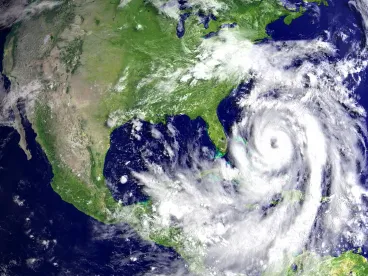Southwest Florida has suffered two devastating and deadly hurricanes in the last six years. Hurricane Irma in 2017 and Hurricane Ian in 2022 were deadly storms that caused billions of dollars in property damage. Florida condominium and homeowners associations take varied approaches in preparing for both imminent and remote hurricane threats, but a few intentional preparations can help community associations recover more effectively and efficiently.
Operational Considerations
Operationally, community associations should prepare for an approaching storm. It is highly advisable to maintain a map and site plan of the property, noting the location of water valves, irrigation controls and critical electrical and sewage infrastructure. This map should be printed and included in a binder considering the high likelihood of a power outage. It is also recommended that community associations take pictures of the property for comparison purposes to demonstrate the extent and timing of damage.
Hurricane Plans and Handbooks
In addition to operational preparations, many community associations will also adopt a detailed hurricane plan. While effective in theory, associations should be cautious when drafting these plans to avoid creating expectations and duties that may not be fulfilled. In general, when community associations undertake an obligation, it comes with a duty of care. If the hurricane plan creates an expectation that the Association will guarantee safety and security during tumultuous times, the reality is that most community associations will not be equipped or trained to meet this expectation. As a result, it is recommended that hurricane plans also include clear disclaimers that owners and residents should not rely on the association for their personal safety and security, and that the association’s staff and vendors may be completely unavailable or unable to access the property.
For example, some hurricane plans claim that the purpose of the plan is to “keep residents safe” and “prevent damage” to the property. Although these are good goals, it is important to remember that community associations are governed by volunteers with families and properties to manage. Hurricane season is also a time when many residents, volunteers, and Board members are residing in their northern homes. In other words, Florida community associations are not built or designed to serve as a first response organization, and it is highly likely that the association will not have sufficient personnel in the moments leading up to and after a devastating storm to guarantee everyone’s safety.
Hurricane Ian flooded many condominium garages, and many of the impacted condominium associations had a hurricane plan requiring staff to move cars to higher elevation. Unfortunately, many residents did not leave a key with the association, there were more cars than elevated parking spaces and the severity of the storm was not known until relatively late and there were many tasks to complete. The result was many expensive cars floating down the street, and owners demanding to know why the association did not move the cars as promised.
Emergency Powers
Next, the Board of Directors should be aware of the Board’s emergency powers in the aftermath of a hurricane. Florida Statutes section 718.1265 provides emergency powers to condominiums and section 720.316 provides emergency powers to homeowners’ associations.
First, specific to condominiums only, the Board should consider Florida Statutes section 718.1265(1)(h) providing that, if emergency powers are available, the Board may require the evacuation of the condominium if the applicable county or city orders an evacuation. More importantly, the statute also provides that the condominium association is immune from liability “should any unit owner or other occupant of a condominium fail or refuse to evacuate the condominium property or association property where the board has required evacuation.” This effectively means that the Board can issue an evacuation order and the Association is immune from liability when a resident stays and is injured.
The Board would not physically remove any resident, but this simple resolution would mitigate significant liability exposure to personal injury. Practically, it would be very difficult to contact the association’s management and legal teams to prepare this evacuation resolution when needed. Hurricane plans should include a pre-drafted resolution for the Board to “fill in the blanks” at an emergency Board meeting. This simple and pre-drafted resolution will immediately allow the Board to take advantage of the statutory immunity.
Second, if a quick decision is required, also note that both condominiums and homeowners’ associations can conduct emergency board meetings with less than the normal notice requirements. Generally, Board meetings will require at least 48 hours posted notice; however, both statutes provide that emergency Board meetings can be conducted with “practicable” notice and without any in-person meeting requirement. This means that if a Board only has three hours to notice an emergency Board meeting via zoom or other digital platform, the notice is proper even though less than 48 hours.
Pre-Existing Contractual Relationships
Finally, it can very difficult, if not impossible, to get contractors and emergency service vendors to the property in the aftermath of a hurricane. Even if there is a vendor with capacity, the Association will have no leverage in negotiations for price or contract terms. After Hurricane Ian, for example, water restoration and debris removal firms were arriving from all over the country and charging high equipment and labor rates imbedded in one-sided contracts that provided the association with no safeguards.
If possible, community associations should work with local and licensed vendors to garner some priority status in the aftermath of a storm. This also opens an opportunity to know the rates and negotiate the contract terms before the storm when there is negotiating leverage, and not in the aftermath of the storm when the Association may be compelled to take any available contractor.
The best laid plans do not always work as intended. Hurricane Ian was an example of shifting currents and paths where community associations quickly went from being outside the cone of uncertainty to the eye of the storm at high tide. As hurricane season approaches, Florida community associations should work with their management team, attorneys, insurance agents, and professionals to preemptively address some of these important concerns.




 />i
/>i

